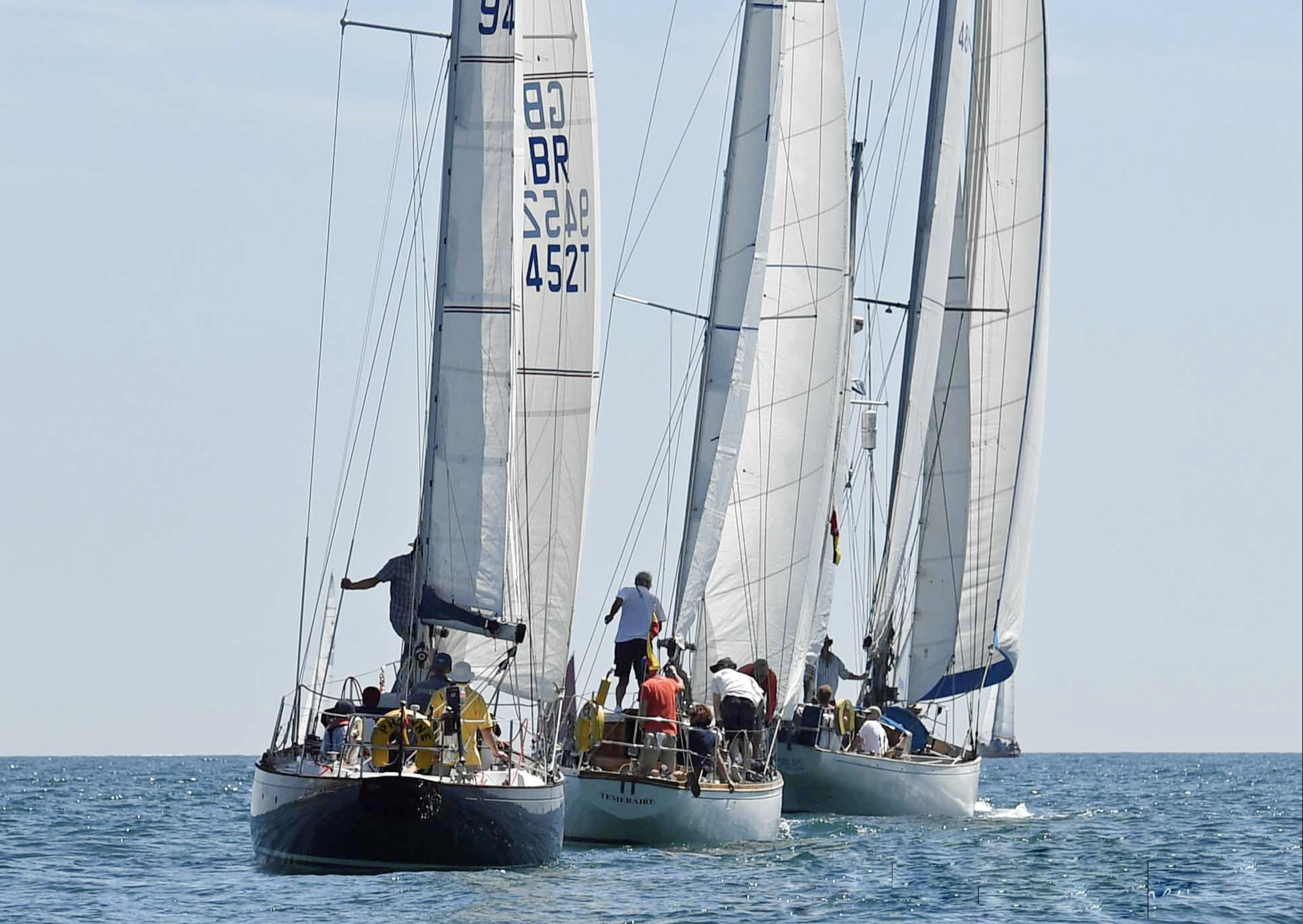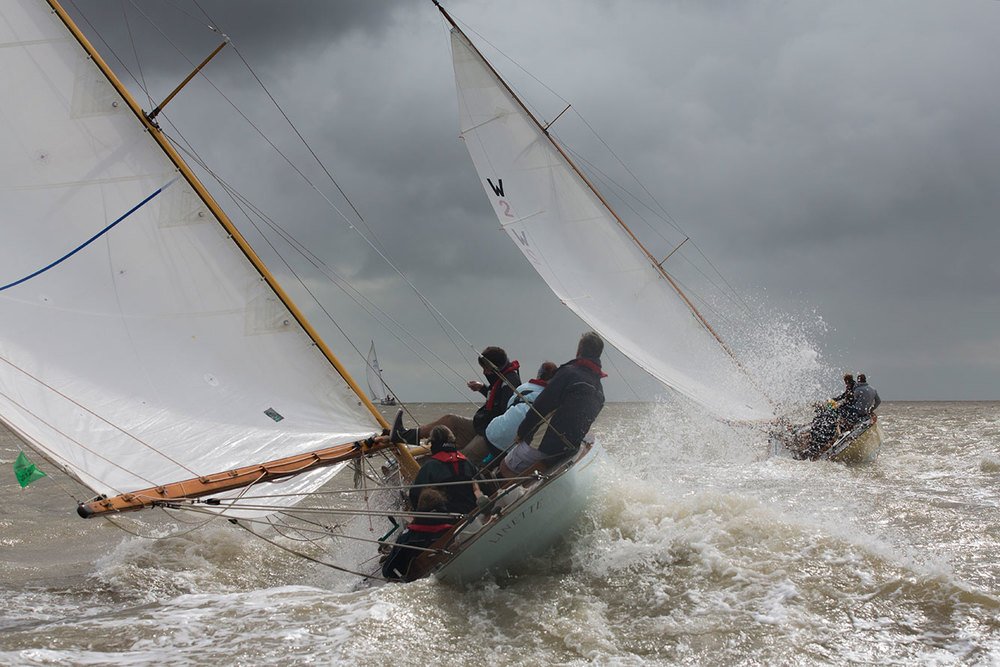The Insoluble Problem of Handicaps
By Mark Chew
Port Phillip’s diverse Classic Fleet-Photo Mark Chew
Why Race at All?
Many wooden yacht owners reading this, will be completely disinterested in racing.
And I understand why…
Yacht racing, in many ways runs in direct opposition to the values of wooden boat custodianship. A deep appreciation of the history, function and aesthetics of a timber boat has little to do with trying to come first. And placing an old vessel under the unnecessary strain of competition, might be seen as potentially damaging to an important piece of history. However, I would like to suggest, perhaps counterintuitively, that the opposite is true.
Firstly, a scheduled race makes us get out of bed. If there are other crew involved, we feel obliged to show up at the yacht club and leave the pen or mooring. Without that diary entry, there’s a good chance that the warm bed sheets are more appealing than a frosty morning sail, and procrastination is so much easier when plans are undefined. And ultimately, all wooden boat owners know that the best way to preserve your boat is to sail it regularly.
Secondly, trying to sail your boat well….and travel fast and efficiently, teaches us to understand the way the design is meant to function. And that depth of understanding feeds into the pool of knowledge around wooden boats.
Finally, the competitive urge, if harnessed properly can act as the catalyst for good maintenance and restoration. As long as an original design is not bastardized in the pursuit of speed, then the quest for racing glory will only enhance the condition of a yacht.
So, if we assume for a minute that racing is a helpful mechanism for improving the number and quality of wooden boats out on the water then what might be the most equitable and effective way to run these races.
The Search for an Equitable System.
There are basically two ways we can handicap a disparate fleet of sailing boats. Neither is perfect and each has its own problems and advantages.
CYCA Great Veterans Race under performance handicap - Photo-Andrea Francolini
Performance Handicaps.
Most classic fleets in Australia and New Zealand use a performance-based handicap system. This basically means that the better you sail, the harsher your handicap becomes… and inversely, if you sail badly you are rewarded with a more competitive handicap for the next outing. I call this the golfers handicap and its low cost, requires no physical measurements, and is relatively easy to administer. It relies on a history of performance for each boat and generally it’s only the outlier results that instigate a change in the handicap number that will, when multiplied by an elapsed time, create a corrected time.
Obviously, what’s attractive about this system is its ease of operation and the small financial costs for both boat owners and race organisers alike. But there are a couple of fundamental problems with performance handicapping that are often ignored. Firstly, its open to abuse. This happens rarely, (I think in 30 years of Classic Yacht racing I’ve only really seen it two or three times). A boat sails a series with a foul hull, old sails, and a novice crew. Come the big end of summer regatta, the bottom is scrubbed a few new sails are fitted and a gun crew steps aboard. Chances are they are going to win! But like I say, this situation is a rarity.
What worries me far more, is that the performance handicap system provides no incentive for maintaining the vessels in a fleet. The inevitable slow decline of sails, hull condition and rigging are factored into the handicap number each race, providing no motivation to maintain a high standard of preparation. In fact, the opposite is true. Poor preparation and malfunctioning equipment are rewarded with a low correction factor.
It has always amused me that amongst Victoria’s Couta fleet, there is often a newer, faster, lighter boat being built, which in the end of the day, after hundreds of thousands of dollars outlay, will only produce a higher handicap number. Perhaps line honours is all that the owners are interested in… a relatively meaningless aim at best.
The Sorrento Couta Boat fleet under Performance handicap. Photo-Mark Chew
Measurement Handicaps
Much in the same way that modern boats race under a handicap system based on empirical measurements such IRC and ORC, it is also possible to rate a classic fleet in this way. Europe is leading the way in developing versions such as The JCH Classic Handicap that has been refined over the past 15 years and is now becoming widely used for classic racing in the UK. Although no handicap can be perfect, it has been designed specifically for classics, it gives fair results and the formula is transparent and in the public domain. It is self-certifying and getting a rating from the dedicated website is simple and free.
The 2022 Classic Channel Regatta run under JCH-Photo Anne Cave-Penney
The CIM system, which operates mostly in the Med is more complex (it runs to 20 pages) and thus expensive. However it has the advantage of encouraging excellence in boat maintenance and restoration. In order to win it is necessary not only to sail well, but also have a boat kept at the highest standards, and in a way that is authentic to the original design of that craft.
Voiles D’Antibes run under CIM Handicapping System
The Fairest of Them All
Of course the best handicap system, isn’t a handicap at all! Race in a one design fleet! Again the Brits have led the way here with classes such as the West Solent One Designs and the Redwing. Here in Australia the primary wooden keel boat one design class is the Tumlaren with ten boats on the water on Port Phillip and a few more opportunities in the wings. Well maitaned boats with good sails and working gear have a clear advantage in this nominally identical fleet.
Redwing One Designs
West Solent One Designs
Melbourne’s One Design Tumlaren Fleet- Photo Mark Chew
A Way Forward
Given the development of user friendly measurement handicap systems over the last few years I think the time has come for one of the Australian or New Zealand Classic Yacht fleets to trial a system based on actual boat data rather than performance. If a particular yacht club is looking to position it self as the home of the local classic fleet offering a classic measurement system handicap would be a great first step. I say this not in the pursuit of any particular desire to see the best sailor win (although that also has to be a good thing) but because incentivising excellence in the condition of our fleets is a key to the success of our little corner of the sailing world.








